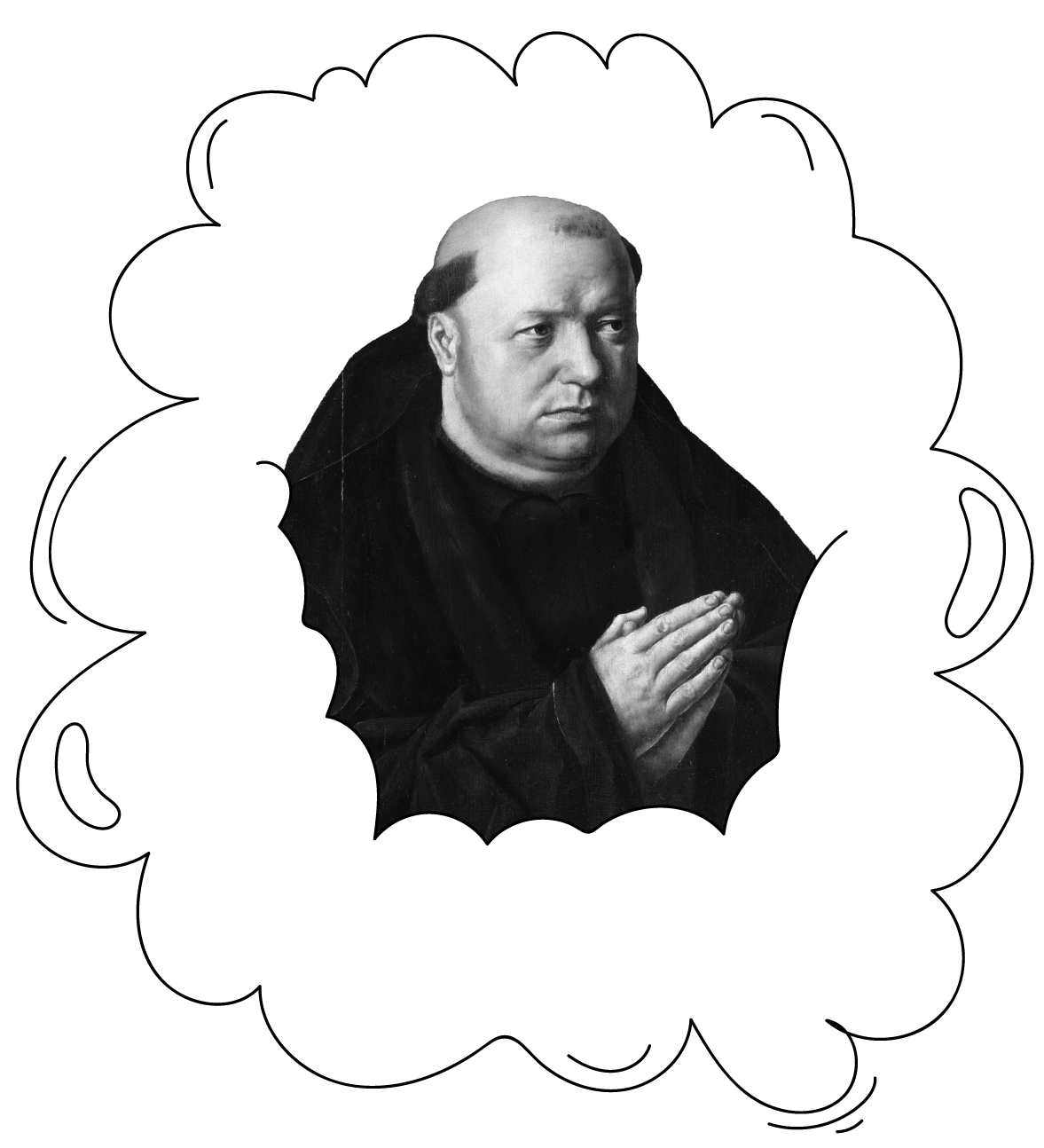“
Don't
know much
about
history.”





T
he term of procrastination probably first appeared in a monastery in the 15th century. Monks wrote latin texts and some of them were not as disciplined as others in doing so. So the term was invented to delimit the ordinary loafer from the elite procrastinator and probably was used ironically with a wink. This could also be a reason why we still use it in mainly academic environments and working fields.
T
he negative connotation of procrastination was greatly strengthened by the industrial revolution and lasts until today. Work became sacred for us and the ideal human image shifted towards accumulating money and becoming respectable. In the time before procrastination was received more neutral and could be interpreted as a smart form of inactiveness. The beginning and growth of capitalist commodity production definitely changed its reception, but it doesn’t mark the start of a negative view on postponing tasks.
T
he term of procrastination probably first appeared in a monastery in the 15th century. Monks wrote latin texts and some of them were not as disciplined as others in doing so. So the term was invented to delimit the ordinary loafer from the elite procrastinator and probably was used ironically with a wink. This could also be a reason why we still use it in mainly academic environments and working fields.
T
he negative connotation of procrastination was greatly strengthened by the industrial revolution and lasts until today. Work became sacred for us and the ideal human image shifted towards accumulating money and becoming respectable. In the time before procrastination was received more neutral and could be interpreted as a smart form of inactiveness. The beginning and growth of capitalist commodity production definitely changed its reception, but it doesn’t mark the start of a negative view on postponing tasks.
T
he term of procrastination probably first appeared in a monastery in the 15th century. Monks wrote latin texts and some of them were not as disciplined as others in doing so. So the term was invented to delimit the ordinary loafer from the elite procrastinator and probably was used ironically with a wink. This could also be a reason why we still use it in mainly academic environments and working fields.
T
he negative connotation of procrastination was greatly strengthened by the industrial revolution and lasts until today. Work became sacred for us and the ideal human image shifted towards accumulating money and becoming respectable. In the time before procrastination was received more neutral and could be interpreted as a smart form of inactiveness. The beginning and growth of capitalist commodity production definitely changed its reception, but it doesn’t mark the start of a negative view on postponing tasks.



Cicero
Cicero
E
ven if the term of procrastination first appeared in a medieval monastery, humanity is procrastinating for much longer and also its negative connotation has been there before the industrial revolution.
C
icero, consul of Rome 44 BC, described the act of procrastination and slowness as hateful in the conduct of almost every affair. With his statement he intended to criticize his political opponent Marcus Antonius, who later had Cicero killed. Almost 800 years before Cicero, the Greek poet Hesiod warned in his poem Work and Days to “not put your work off till tomorrow and the day after”, which describes an even nowadays widely spreaded ideal. We can find many other examples of moral quotes on procrastination in history. Probably the act of postponing was born with the work task itself and the possibilities to avoid it.
E
ven if the term of procrastination first appeared in a medieval monastery, humanity is procrastinating for much longer and also its negative connotation has been there before the industrial revolution.
C
icero, consul of Rome 44 BC, described the act of procrastination and slowness as hateful in the conduct of almost every affair. With his statement he intended to criticize his political opponent Marcus Antonius, who later had Cicero killed. Almost 800 years before Cicero, the Greek poet Hesiod warned in his poem Work and Days to “not put your work off till tomorrow and the day after”, which describes an even nowadays widely spreaded ideal. We can find many other examples of moral quotes on procrastination in history. Probably the act of postponing was born with the work task itself and the possibilities to avoid it.
E
ven if the term of procrastination first appeared in a medieval monastery, humanity is procrastinating for much longer and also its negative connotation has been there before the industrial revolution.
C
icero, consul of Rome 44 BC, described the act of procrastination and slowness as hateful in the conduct of almost every affair. With his statement he intended to criticize his political opponent Marcus Antonius, who later had Cicero killed. Almost 800 years before Cicero, the Greek poet Hesiod warned in his poem Work and Days to “not put your work off till tomorrow and the day after”, which describes an even nowadays widely spreaded ideal. We can find many other examples of moral quotes on procrastination in history. Probably the act of postponing was born with the work task itself and the possibilities to avoid it.
Cicero
Cicero
Cicero

G
eoffry Chaucer, Samuel Johnson, Samuel Taylor Coleridge, Francis Bacon and many more. The list of famous procrastinators is long and paradoxically we know these people for their great achievements. But sometimes we also know them for the work they did while procrastinating.
L
eonardo Da Vinci is one of the most famous examples for this phenomenon. In his lifetime he completed fewer than 20 paintings, spending 16 years on the Mona Lisa alone. That doesn’t mean he was sitting 16 years in a room painting. Most of the time he was doodling crazy things like a helicopter, a metal-rolling mill and the wheel-lock musket, plus sophisticated designs for bridges, a moveable dyke for Venice and highly accurate maps that were sometimes centuries ahead of their time. So what can we learn from Da Vinci? Procrastination doesn’t have to be unproductive. However, it often is. Samuel Johnson described it as “one of the general weaknesses, which [...] prevail to a greater or less degree in every mind.”
G
eoffry Chaucer, Samuel Johnson, Samuel Taylor Coleridge, Francis Bacon and many more. The list of famous procrastinators is long and paradoxically we know these people for their great achievements. But sometimes we also know them for the work they did while procrastinating.
L
eonardo Da Vinci is one of the most famous examples for this phenomenon. In his lifetime he completed fewer than 20 paintings, spending 16 years on the Mona Lisa alone. That doesn’t mean he was sitting 16 years in a room painting. Most of the time he was doodling crazy things like a helicopter, a metal-rolling mill and the wheel-lock musket, plus sophisticated designs for bridges, a moveable dyke for Venice and highly accurate maps that were sometimes centuries ahead of their time. So what can we learn from Da Vinci? Procrastination doesn’t have to be unproductive. However, it often is. Samuel Johnson described it as “one of the general weaknesses, which [...] prevail to a greater or less degree in every mind.”
G
eoffry Chaucer, Samuel Johnson, Samuel Taylor Coleridge, Francis Bacon and many more. The list of famous procrastinators is long and paradoxically we know these people for their great achievements. But sometimes we also know them for the work they did while procrastinating.
L
eonardo Da Vinci is one of the most famous examples for this phenomenon. In his lifetime he completed fewer than 20 paintings, spending 16 years on the Mona Lisa alone. That doesn’t mean he was sitting 16 years in a room painting. Most of the time he was doodling crazy things like a helicopter, a metal-rolling mill and the wheel-lock musket, plus sophisticated designs for bridges, a moveable dyke for Venice and highly accurate maps that were sometimes centuries ahead of their time. So what can we learn from Da Vinci? Procrastination doesn’t have to be unproductive. However, it often is. Samuel Johnson described it as “one of the general weaknesses, which [...] prevail to a greater or less degree in every mind.”












Click on an entry
of the browser history
on the right
to open the videos